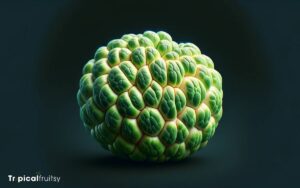Where Do Custard Apples Grow: Exploring the Ideal Regions!
Custard apples (cherimoya) flourish in tropical climates and are native to South America. They are widely cultivated in India, Mexico, and the Philippines, and are also found in Australia, Africa, and warmer North American areas.
Each region contributes distinct cultivation techniques to suit local environments, ensuring the fruit’s sweet, creamy taste is enjoyed globally.
Custard apples favor warm and humid climates for optimal growth. Their cultivation has been adopted in various parts of the world, each adapting its farming methods to local conditions.
For instance:
Custard apples’ global cultivation reflects their adaptability and the universal appeal of their sweet, creamy flavor.
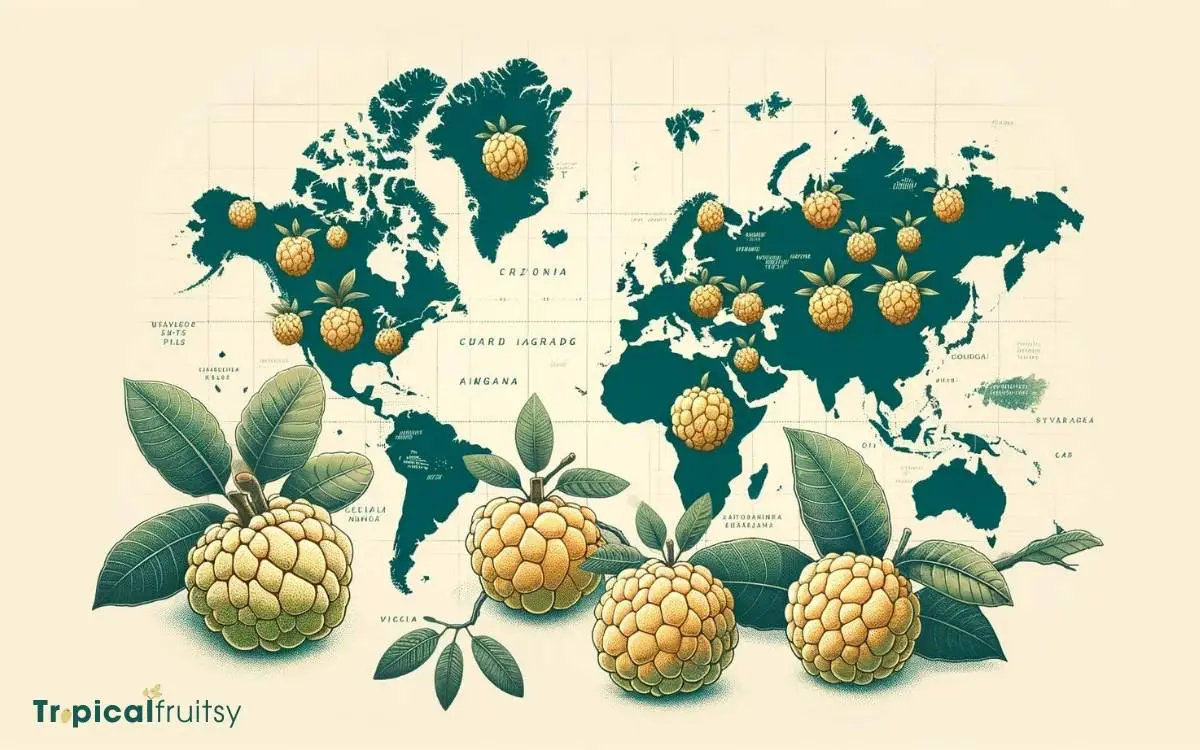
Key Takeaway
Origins of Custard Apples

I’ve learned that custard apples, also known as Annona reticulata, originated from the tropical rainforests of Central America and the West Indies. These regions provided the ideal conditions for the evolution and diversification of the Annona genus.
Custard apples belong to the Annonaceae family, which consists of approximately 129 genera and 2300 species.
The taxonomy of this fruit has been well-documented, with its unique heart-shaped morphology and compound fruit structure arising from the confluence of multiple ovaries.
Genetically, A. reticulata has adapted to its native humid, warm climate with a relatively stable ecosystem, favoring its propagation and natural distribution.
Understanding these origins is vital in cultivating the species, as it directly influences their agronomic requirements. This brings us to the preferred climatic conditions for their growth.
Preferred Climatic Conditions
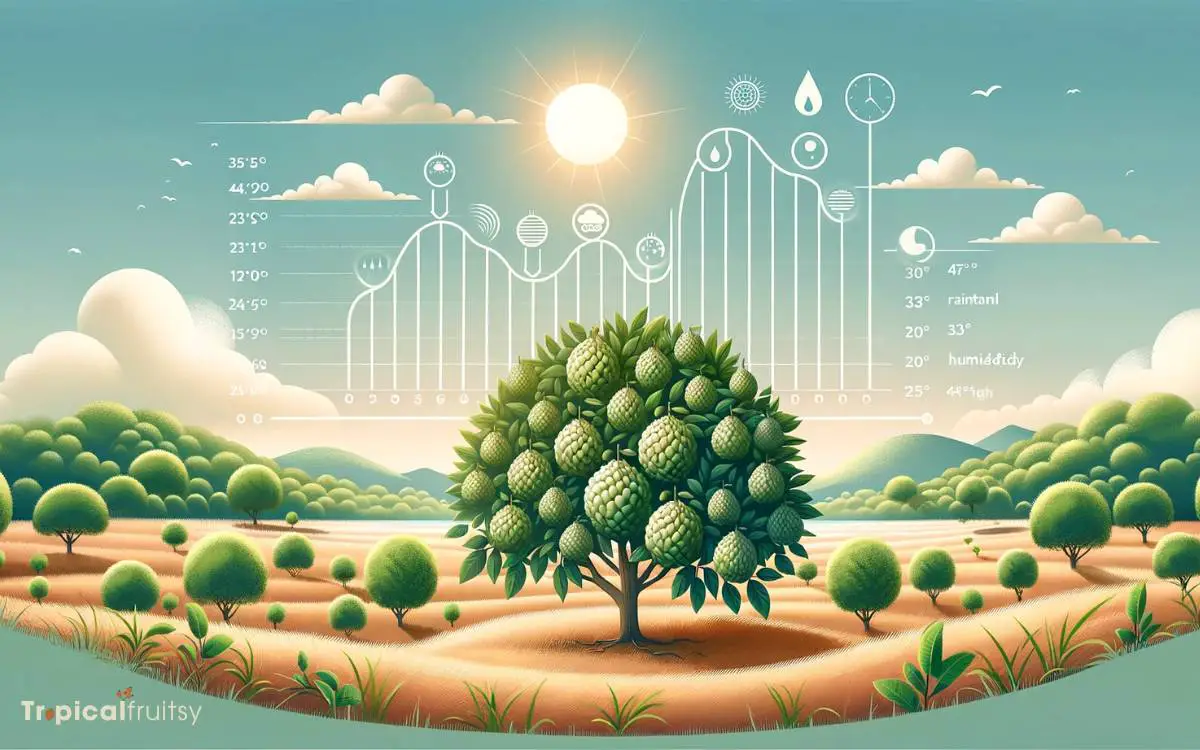
I’ve observed that custard apples exhibit optimal growth within warm tropical regions where temperatures consistently hover above the frost threshold.
These areas are typically frost-free, a non-negotiable condition for the survival and fruiting of the species.
High humidity levels, often exceeding 70%, are also crucial in promoting the physiological processes that lead to successful flowering and fruit development in custard apples.
Warm Tropical Regions
As a tropical fruit enthusiast, I’ve found that custard apples thrive in warm tropical regions, where the climate’s consistent warmth and humidity are essential for their growth.
They particularly flourish in areas with a distinct wet and dry season, which aligns with their need for a period of lower rainfall during flowering and fruit set.
| Climate Factor | Requirement for Custard Apples |
|---|---|
| Temperature Range | 25°C to 28°C (optimal) |
| Annual Rainfall | 750 to 2,500 mm |
| Relative Humidity | 60% to 80% during flowering |
| Dry Season Length | 2 to 4 months (for fruit set) |
| Soil Type | Well-drained, fertile loam |
These conditions are critical to avoid common issues like fruit splitting and fungal diseases, which can significantly impact yield and fruit quality.
Frost-Free Environments
While exploring various climates where custard apples prosper, I’ve noticed they require frost-free environments to ensure their delicate flowers and developing fruits aren’t damaged by cold temperatures.
The plant’s biology dictates a preference for consistent warmth, typically found in regions with a tropical or subtropical climate.
These environments provide the thermal stability custard apples need, particularly in their flowering and fruit-setting stages.
Temperature fluctuations, especially those dipping below 28°F (-2°C), can result in cellular damage within the plant tissue, impeding growth and potentially killing young blooms.
Therefore, successful cultivation hinges on the absence of frost, positioning the plant for optimal development.
Regions that experience mild winters without episodes of freezing are ideal, offering the custard apple the climatic sanctuary it requires for prosperous growth.
High Humidity Levels
How do high humidity levels affect the growth of custard apples in their preferred climatic conditions?
High humidity is pivotal in the cultivation of custard apples. The plant’s physiology is such that it thrives in moist environments, which facilitate vital processes like transpiration and photosynthesis.
The transpiration rate, in particular, is moderated by ambient humidity, reducing water stress and aiding in the optimal uptake of nutrients.
Furthermore, the presence of high humidity can diminish the incidence of certain pests and diseases that prefer dry conditions.
However, I should note that excessive humidity can foster fungal infections, necessitating a delicate balance.
Therefore, as a grower, I’m always monitoring relative humidity levels to ensure they hover around the ideal range for custard apple cultivation—moderately high but not excessive, to promote healthy growth and fruit development.
Leading Producers Worldwide
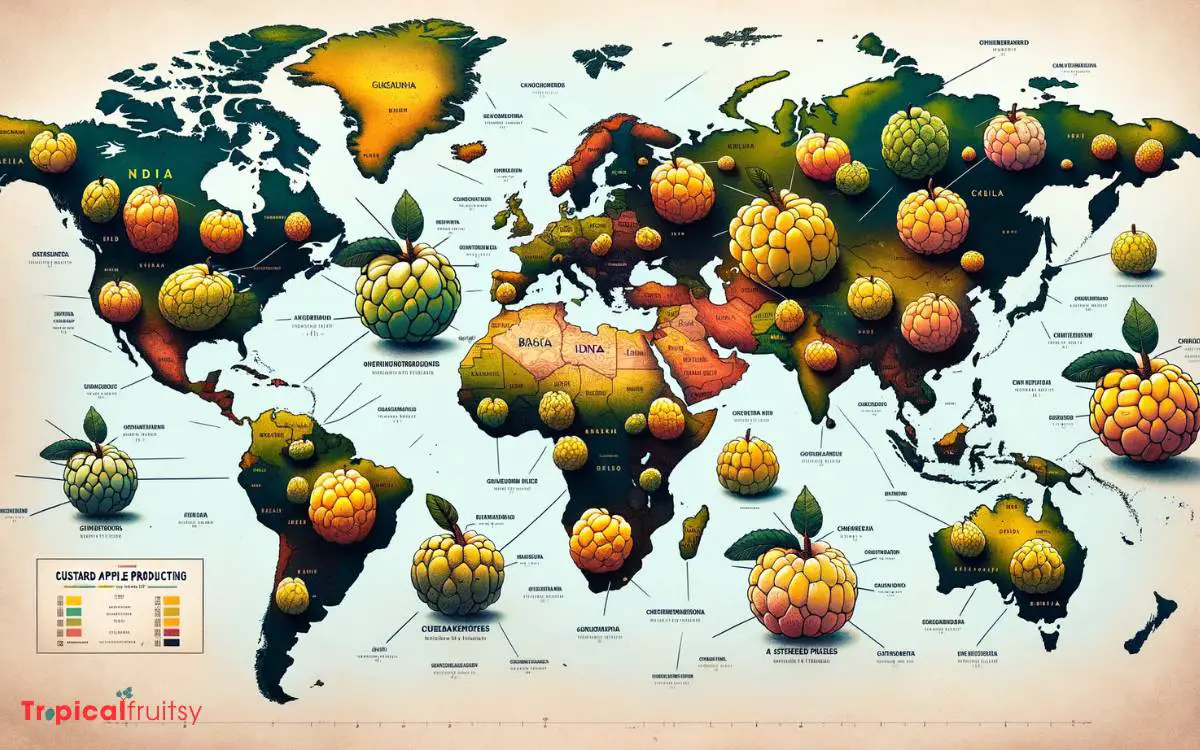
I often find that India, China, and Brazil are among the top producers of custard apples globally.
These countries possess the ideal climatic conditions that are conducive to the growth of the Annona genus, particularly Annona squamosa, the species commonly referred to as custard apple.
India leads the production, with a significant portion of its output originating from regions that offer a subtropical climate, which the custard apple tree favors. The state of Maharashtra, in India, is particularly notable for its high yield.
China follows, with its diverse climates allowing for substantial cultivation, especially in the Yunnan province. Brazil’s contribution is also noteworthy, with its tropical climate providing year-round growing conditions.
The collective output of these regions significantly influences global availability and market dynamics of custard apples.
Cultivation in South America

South America’s climate affords it a unique advantage in cultivating custard apples, as I’ve observed in countries like Brazil, where the fruit thrives year-round.
The region’s warm temperatures and consistent rainfall create an ideal environment for Annona squamosa, the species most commonly known as the custard apple.
In analyzing the growth patterns, it’s evident that the fruit’s success is closely tied to specific climatic conditions.
To illustrate, let’s examine a table that compares two South American countries in their approach to custard apple cultivation:
| Country | Cultivation Insights |
|---|---|
| Brazil | Utilizes the tropical climate; year-round production with peak season from October to January. |
| Peru | Favors coastal regions with dry, subtropical climate; harvest is typically from January to April. |
| Ecuador | Embraces diverse microclimates; altitudinal range allows for staggered harvesting periods. |
| Colombia | Leverages Andean climatic variability; microclimates enable both highland and lowland production. |
| Venezuela | Combats higher precipitation levels with improved drainage and canopy management techniques. |
This analytical perspective showcases the scientific nuances that influence custard apple cultivation across South America.
Custard Apples in Asia

Turning my attention to Asia, I find that the region’s diverse climates provide a range of environments where custard apples thrive, particularly in tropical zones with distinct wet and dry seasons.
I’ll explore how regional cultivation practices, adapted to local conditions, contribute to the fruit’s quality and yield.
It’s evident that traditional and modern agricultural techniques intersect in Asia, offering a unique perspective on custard apple production.
Asian Climate Suitability
Several Asian countries offer the warm, humid climates that custard apples need to thrive. These regions typically experience a monsoon-influenced climate, characterized by distinct wet and dry seasons, which is quite conducive to the growth of custard apples.
I’ve analyzed the climatic requirements and found that these fruits demand temperatures ranging between 25°C to 28°C and annual rainfall of about 600 to 1000 millimeters, optimally distributed during the growing period.
To illustrate, here’s a table reflecting the suitability of different Asian regions based on key climatic parameters:
| Region | Average Temperature (°C) | Annual Rainfall (mm) |
|---|---|---|
| Southeast Asia | 27 | 1500 |
| South Asia | 26 | 1100 |
| East Asia | 15-23 | 800-900 |
These figures affirm that Southeast and South Asia, with their warmer temperatures and higher precipitation levels, are especially suited for the cultivation of custard apples.
East Asia’s lower temperatures and rainfall can be limiting factors but may still support growth in specific microclimates.
Regional Cultivation Practices
I’ve discovered that many Asian farmers employ traditional and innovative practices to cultivate custard apples effectively in their varied regional climates.
These practices are crafted to optimize yield, maintain plant health, and ensure fruit quality.
My analysis has revealed a pattern of methods used across different regions:
- Propagation: Utilizing grafting techniques for consistency and disease resistance.
- Soil Management: Implementing organic matter enrichment and pH balancing.
- Irrigation: Tailoring water supply to the seasonal needs and developmental stages of the plant.
- Pest Control: Employing integrated pest management, combining biological control agents with minimal chemical interventions.
- Harvesting: Timing the harvest to balance fruit maturity and market demand, ensuring peak flavor and texture.
These points underscore the meticulous attention Asian farmers give to the varying environmental conditions that affect custard apple cultivation.
Growth in Australia and Oceania

In Australia and Oceania, custard apples thrive in the region’s warm climates and are particularly popular among local growers.
I’ve observed that Annona reticulata, the species commonly referred to as custard apple, exhibits a robust growth pattern in these areas, owing to the favorable climatic conditions that align with the plant’s native habitat requirements.
The tree requires a frost-free environment with well-distributed rainfall, making parts of Australia’s coastal regions ideal for cultivation.
Moreover, the introduction of advanced horticultural practices, including grafting techniques and controlled irrigation systems, has further optimized yield and fruit quality.
Scientific analysis of soil composition and PH levels is routinely conducted to ensure the plant’s specific nutrient needs are met.
This meticulous approach has resulted in a flourishing custard apple industry, with Australia exporting a significant quantity of the fruit to meet global demands.
African Countries and Cultivation

As I turn my attention to Africa, it’s clear that the continent’s diverse climates provide suitable conditions for cultivating custard apples, particularly in tropical and subtropical regions.
The plant thrives in areas with distinct wet and dry seasons, which is characteristic of several African countries.
Here’s an analytical look at the factors influencing custard apple cultivation in Africa:
- Temperature: Optimal growth occurs between 25°C and 28°C.
- Altitude: They’re commonly grown at altitudes up to 1000 meters above sea level.
- Soil: Well-drained, fertile soils with a neutral to slightly acidic pH are preferred.
- Precipitation: Adequate rainfall or irrigation is crucial during the growing period.
- Propagation: Seeds and grafting methods are employed for propagation.
This understanding is crucial as we consider the adaptation of custard apples in other regions, like North America.
Adaptation in North America
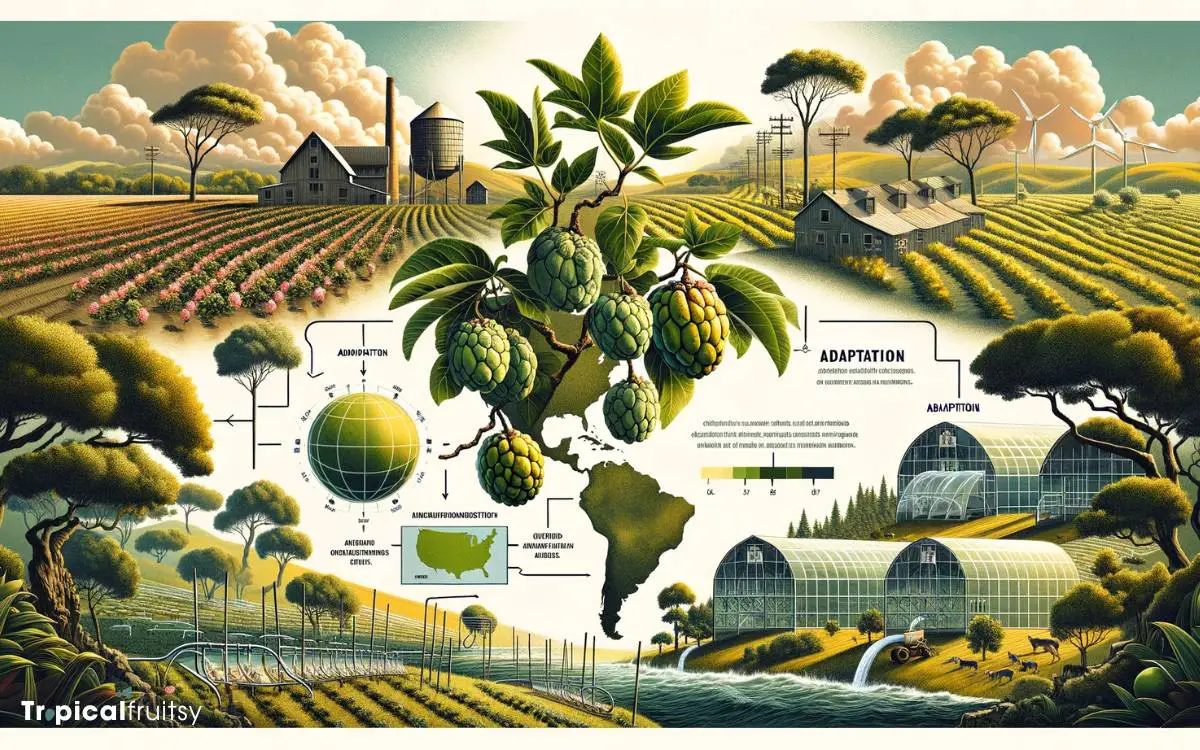
While exploring the cultivation of custard apples in Africa has highlighted key environmental needs, I’ll now examine how these factors translate to the growth of these fruits in North America.
Custard apples, or Annona species, require specific climatic conditions that are best met in subtropical regions.
In North America, these conditions are found predominantly in the southern parts of the continent, where temperatures rarely drop below freezing.
The adaptation of custard apples to North American soil involves careful consideration of frost tolerance, as the trees are sensitive to cold snaps that can occur unexpectedly.
Cultivars developed for resilience to such temperature fluctuations are crucial. Moreover, the fruit’s success in North America depends on soil quality—well-drained, slightly acidic to neutral soils are optimal.
Proper irrigation practices are also vital to ensure the trees receive adequate moisture without waterlogging, which can lead to root rot.
Challenges in Custard Apple Farming
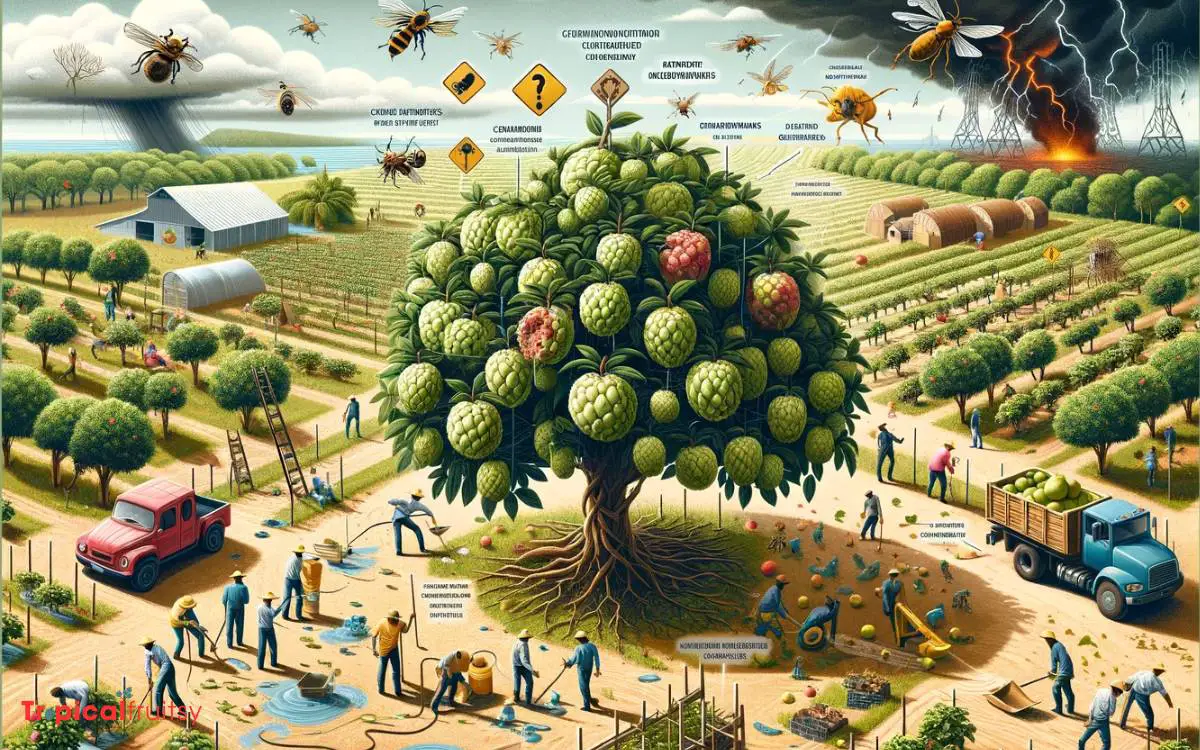
How, then, do we address the challenges that custard apple farmers face, given the tree’s sensitivity to cold and need for well-drained soils?
It’s essential to implement strategies that enhance the tree’s resilience and ensure optimal growing conditions are maintained.
Delving into the scientific intricacies, I’ve identified key factors that must be managed:
- Temperature Regulation: Employing frost protection measures such as windbreaks or heating to mitigate cold damage.
- Soil Composition: Amending soil with organic matter to improve drainage and root health.
- Pest Management: Utilizing integrated pest management to control pests like the fruit fly without disrupting the ecosystem.
- Irrigation Techniques: Implementing drip or micro-sprinkler systems to provide consistent moisture while conserving water.
- Crop Diversification: Including other compatible crops to reduce economic risk and improve biodiversity.
Conclusion
In sum, custard apples thrive in warm, tropical climates, yet they’re surprisingly adaptable.
Coincidentally, as I delve into the nuances of their cultivation, it’s evident that soil quality, humidity, and careful management of pests pose significant challenges. These factors profoundly affect yield and quality.
Therefore, understanding the specific environmental and agronomic conditions is essential for successful cultivation.
This scientific analysis underscores the complexity behind the sweet simplicity of the custard apples gracing our tables.






